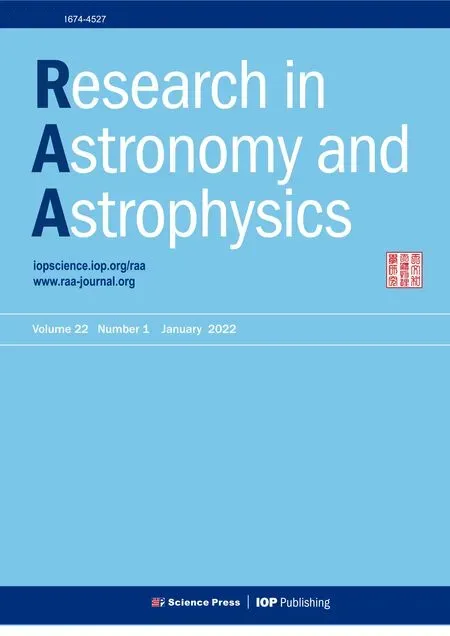Research in Astronomy and Astrophysics
- Case Study on the γ-algorithm: Possible Tests from the Luminosity versus Displacement Correlation of High Mass X-Ray Binaries
- What Can We Learn from the Geoeffectiveness of the Magnetic Cloud on 2012 July 15-17?
- Molecular Clump Extraction Algorithm Based on Local Density Clustering*
- GGCHEMPY: A Pure Python-based Gas-grain Chemical Code for Efficient Simulation of Interstellar Chemistry*
- Are There Magnetars in High-mass X-Ray Binaries?*
- Probing the Large-scale Structure of the Universe Through Gravitational Wave Observations
- The Investigation of the Dynamical Evolution of Extrasolar Three-planetary System GJ 3138
- Machine Learning for Improving Stellar Image-based Alignment in Widefield Telescopes
- On Mechanisms of Proton Perpendicular Heating in the Solar Wind: TestResults Based on Wind Observations
- AGN Lifetimes in UV-selected Galaxies:A Clue to Supermassive Black Holegalaxy Coevolution
- B3 0749+460A: A New Repeat “Changing-look” Active Galactic Nucleus Associated with X-Ray Spectral Slope Variations
- North Celestial Region Observed with 21 CentiMeter Array
- Analysis of TESS Field Eclipsing Binary Star V948 Her:A Pulsating or Nonpulsating Star?
- The Variability of the Narrow-line Seyfert 1 Galaxies from the Pan-STARRS’s View
- Strong Spatial Aggregation of Martian Surface Temperature Shaped by Spatial and Seasonal Variations in Meteorological and Environmental Factors
- Spot and Facula Activity Variations of the Eccentric Detached Eclipsing Binary KIC 8098300 Based on the Time-series Orbital Solutions
- Transient Phenomena from Gas Erupting Neutron Stars
- Alpha/proton Instability in the Presence of Proton and Alpha Temperature Anisotropy and its Application to the Deceleration of Alpha Particles in the Solar Wind
- The Precursor Phase of an X-class Flare: Magnetic Reconnection,Powering and Non-thermal Electrons
- On Dark Gravitational Wave Standard Sirens as Cosmological Inference and Forecasting the Constraint on Hubble Constant using Binary Black Holes Detected by Deci-hertz Observatory
- A Stellar Ranging Scheme Based on the Second-order Correlation Measurement
- Photometric and Spectroscopic Analysis of LBV Candidate J004341.84+411112.0 in M31
- Research in Astronomy and Astrophysics

